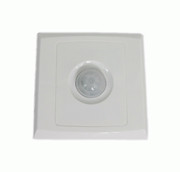The human body is an emitter of a specific wavelength of infrared light. The infrared sensor detects the change of the infrared ray and amplifies and selects the frequency to drive the appropriate load. This is the human body infrared automatic switch. This detection technology is more sensitive and accurate than ultrasound, mute, and microwave. It requires PIR pyroelectric human body infrared sensor signal amplification processing circuit has high sensitivity and can accurately identify the movement of organisms and non-living organisms, so that the misoperation rate is minimized. And the volume is small, and the self-consumption is small. The switch composed of a pyroelectric infrared sensor and a dedicated monolithic integrated circuit can be turned on and off. It is easy to install and can directly replace the Type 86 panel switch without changing the mains circuit.
The PIR (HWTT) pyroelectric infrared sensor has a small output signal amplitude (less than 1 mV), a low frequency (about 0.1 to 0.8 Hz), and a short detection distance. Therefore, a hemispherical Fresnel lens is added before the PIR. The range is extended to a detection surface with a 90 degree conical distance greater than 5 meters. The integrated circuit contains circuits such as a secondary operational amplifier, a comparator, a timer, a zero-crossing detection, a control circuit, and a system clock. The PIR sensor detects the change of the infrared thermal energy caused by the movement of the human body and converts it into a voltage quantity, and compares the input to the control circuit through the second-stage frequency selective amplification, and the zero-crossing pulse is triggered by the control circuit to trigger the two-way thyristor conduction. The use of AC zero-crossing trigger can eliminate the surge current when the thyristor is turned on and prolong the service life of the luminaire. At the same time, the control circuit starts the timer until the PIR sensor triggers the thyristor signal to the set time after the signal is received, and then turns off the thyristor to automatically turn off. Changing the R5 resistance or C4 capacity controls the time of the timer. The 9-pin of the IC circuit is the light-control input terminal, which is grounded by the photoresistor series R8. The daytime bright resistance is small and the 9-pin is low level. The output of the control circuit is blocked. When the sky is dark, the bright resistance increases and the 9-pin turns to the high level. And the control circuit is released, so that the automatic switch can be automatically turned into work when it is dark. Adjust the R8 resistor to accommodate different sensitivities. To change it to work day and night, simply remove the photoresistor or R8. The adjustment of the detection sensitivity is also very convenient. Increasing the resistance of the R9 resistor increases the gain of the amplifier, which can increase the detection distance, and vice versa, the detection distance can be shortened, and can generally be adjusted between 2 and 8 meters. This circuit can be successfully completed as long as the components are selected correctly and the soldering is correct.
The PIR (HWTT) pyroelectric infrared sensor has a small output signal amplitude (less than 1 mV), a low frequency (about 0.1 to 0.8 Hz), and a short detection distance. Therefore, a hemispherical Fresnel lens is added before the PIR. The range is extended to a detection surface with a 90 degree conical distance greater than 5 meters. The integrated circuit contains circuits such as a secondary operational amplifier, a comparator, a timer, a zero-crossing detection, a control circuit, and a system clock. The PIR sensor detects the change of the infrared thermal energy caused by the movement of the human body and converts it into a voltage quantity, and compares the input to the control circuit through the second-stage frequency selective amplification, and the zero-crossing pulse is triggered by the control circuit to trigger the two-way thyristor conduction. The use of AC zero-crossing trigger can eliminate the surge current when the thyristor is turned on and prolong the service life of the luminaire.

zhangjiagang wellyoung material co.,ltd , https://www.wellyoung-board.com
